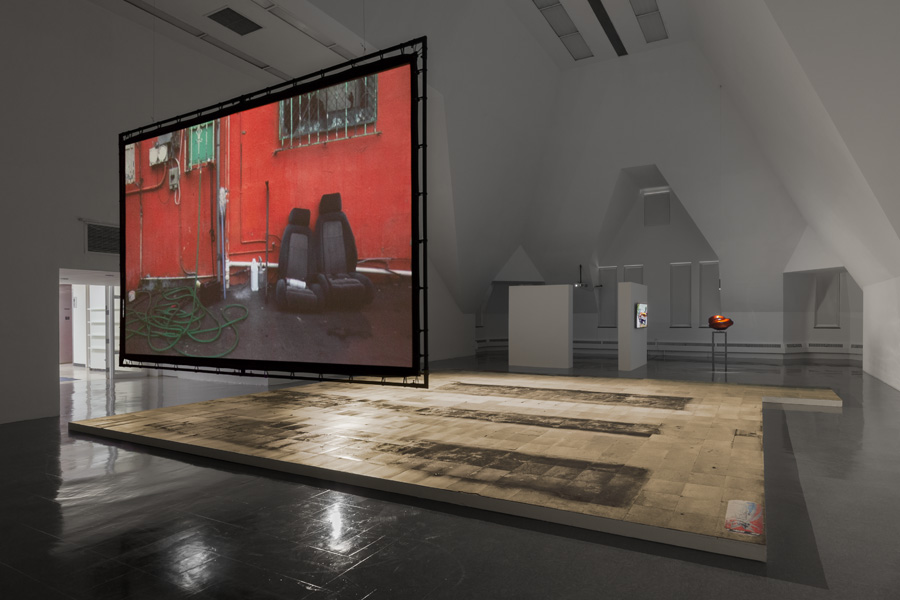Shadi Habib Allah Reveals the Socioeconomic Structures of Underprivileged Communities
An exhibition at The Renaissance Society, Chicago, shows the artist's investigation into the ways labour and debt operate in Miami's Liberty City
An exhibition at The Renaissance Society, Chicago, shows the artist's investigation into the ways labour and debt operate in Miami's Liberty City

It is difficult to determine exactly where the artistic process of Shadi Habib Allah ends and the lives of his subjects begin. The Miami and New York-based, Palestinian-born artist often implicates himself in his works, which result from intensive, embedded research in the cultural contexts and socioeconomic power structures they investigate. In ‘Put to Rights’, films, sculptures and an installation document makeshift systems of exchange for goods and services, highlighting the ways labour and debt operate on a local level, particularly in underprivileged communities.
In the dimly lit, vaulted gallery of the Renaissance Society, Habib Allah showcases a selection of works from the last eight years alongside two new works made in 2018. These latest works further his engagement with the subcultures and alternative economies of Liberty City, Miami, an area marked by historical racial disenfranchisement. 70 Days Behind Inventory (2018), the show’s central installation, employs material sourced directly from one of the Liberty City convenience stores that operate as sites for cash exchange in the absence of local banks. Vinyl floor tiles from this bodega have been installed on the floor in the middle of the gallery. Scuffed and stained from use, the tiles are notched where shelving units once stood, an eerie evocation of absent bodies.

Perhaps the most startling body of work in the exhibition, Dropping the 10th Digit (2018), is a series of eight photographic prints on Duratrans film mounted on lightboxes. In these works, scraps of yellowing paper provide a scratch pad for hand-scribbled receipts logging individual customer debts and trades of food stamps for cash. Nicknames and first names are sufficient identifiers for the transactions: one receipt records minor purchases by ‘Mama Girl’, another by ‘David’ and ‘David’s Wife.’ The glowing images archive systems of economic exchange exceptional for their intimacy, a friendly trust in marked contrast to the swift, impersonal automation of modern finance.
In Habib Allah’s films, the lines often blur between the personal and the political, the real and the staged. Such is the case with S/N: 8F1GNA0021 (2012), a video camera acquired on the black market, encased in a fibreglass shell lacquered with glossy automotive paint. The camera appears to project a film on a wall that stands opposite: in it, two men acquire a stolen video camera and then sculpt its case in an auto body shop. They banter while they work, commenting on the ‘hot’ (stolen) cars that clients and co-workers have brought to the shop for custom details. In the scene, the difference between sanctioned and illicit economies becomes increasingly superficial, no thicker than fibreglass.

Across the gallery, Habib Allah’s 2010 film The King and the Jester (2010) is projected on a much larger screen. The film documents daily activity at Auto Paint and Body Shop in Liberty City: workers assess new cars as they arrive and banter while they tune them up. In one tender scene, workers exchange foot massages after a long day, an intimate moment of care in a hyper-masculinized environment. While receiving his massage, one man asks: ‘Who gonna feel my pain?’ His heart-breaking question of empathy highlights the political and economic neglect that makes the black market necessary in places like Liberty City. It also questions our position as viewers: are we entitled to witness his pain, when film preserves it only as remote spectacle?
Though Habib Allah lives in Miami, his own relationship to Liberty City remains unclear. There is a certain distance between filmmaker and subject – the distance of a spectator – in shots from the hollow trunk of a car or through the back windshield of a parked car. Nevertheless, his editing preserves the individuality of his subjects, and his works are most impactful when they highlight the small gestures of care – handwritten personalized receipts or impromptu foot massages – that enable communities to survive the violence of late capitalism.
Shadi Habib Allah, 'Put to Rights' runs at The Renaissance Society, Chicago, until 4 November 2018.
Main image: Shadi Habib Allah, 'Put to Rights', 2018, installation view. Courtesy: The Renaissance Society at the University of Chicago; photograph: Useful Art Services






















